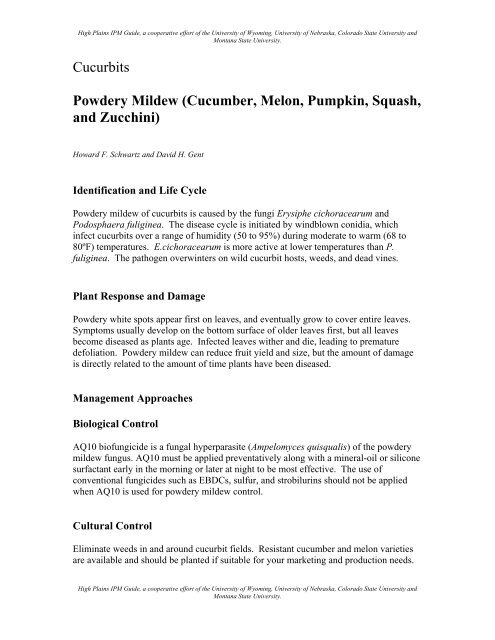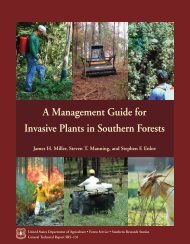Cucurbits XXX - Powdery Mildew
Cucurbits XXX - Powdery Mildew
Cucurbits XXX - Powdery Mildew
- No tags were found...
You also want an ePaper? Increase the reach of your titles
YUMPU automatically turns print PDFs into web optimized ePapers that Google loves.
High Plains IPM Guide, a cooperative effort of the University of Wyoming, University of Nebraska, Colorado State University andMontana State University.<strong>Cucurbits</strong><strong>Powdery</strong> <strong>Mildew</strong> (Cucumber, Melon, Pumpkin, Squash,and Zucchini)Howard F. Schwartz and David H. GentIdentification and Life Cycle<strong>Powdery</strong> mildew of cucurbits is caused by the fungi Erysiphe cichoracearum andPodosphaera fuliginea. The disease cycle is initiated by windblown conidia, whichinfect cucurbits over a range of humidity (50 to 95%) during moderate to warm (68 to80ºF) temperatures. E.cichoracearum is more active at lower temperatures than P.fuliginea. The pathogen overwinters on wild cucurbit hosts, weeds, and dead vines.Plant Response and Damage<strong>Powdery</strong> white spots appear first on leaves, and eventually grow to cover entire leaves.Symptoms usually develop on the bottom surface of older leaves first, but all leavesbecome diseased as plants age. Infected leaves wither and die, leading to prematuredefoliation. <strong>Powdery</strong> mildew can reduce fruit yield and size, but the amount of damageis directly related to the amount of time plants have been diseased.Management ApproachesBiological ControlAQ10 biofungicide is a fungal hyperparasite (Ampelomyces quisqualis) of the powderymildew fungus. AQ10 must be applied preventatively along with a mineral-oil or siliconesurfactant early in the morning or later at night to be most effective. The use ofconventional fungicides such as EBDCs, sulfur, and strobilurins should not be appliedwhen AQ10 is used for powdery mildew control.Cultural ControlEliminate weeds in and around cucurbit fields. Resistant cucumber and melon varietiesare available and should be planted if suitable for your marketing and production needs.High Plains IPM Guide, a cooperative effort of the University of Wyoming, University of Nebraska, Colorado State University andMontana State University.
High Plains IPM Guide, a cooperative effort of the University of Wyoming, University of Nebraska, Colorado State University andMontana State University.Several races of the powdery mildew fungi have been identified, and resistant varietiesmust be matched against the prominent races of the pathogens to be most effective.Chemical ControlChemical controls must be used in combination with cultural controls to be mosteffective. Resistance to several fungicides has been reported in the powdery mildewfungi, so fungicides with different modes of action must be rotated or tank-mixed toprevent or delay resistance development. Thorough coverage is essential for effectivedisease control.Product List for <strong>Powdery</strong> <strong>Mildew</strong>:PesticideProductper acreApplicationFrequency(days)Chlorothalonil and Chlorothalonil MixturesBravo 7201.5-2 pt 7 daysRemarksDo not graze or feed debris tolivestock; 7 day PHIBravo Ultrex 1.4-1.8 lb 7-10 days Maximum of 16.5 pounds perseason; 0 day PHIBravo WeatherStik 1.5-2.0 pt 7-10 days Maximum of 20 pints perseason; 0 day PHIEcho 720 1.5-2.0 pt 7-10 days Maximum of 2.5 gallons perseason; 7 day PHIEcho 90DF 1.2-1.6 lb 7-10 days Maximum of 16.67 pounds perseason; 7 day PHIEcho Zn 2.2 to 2.8 pt 7-10 days Maximum of 3.6 gallons perseason; 7 day PHIRidomil/Bravo 1-2 lb 7-14 days 7 day PHICopper FungicidesChamp Dry Prill 1.33 lb 5-7 daysChamp Formula 2 1.33 pt 5-7 daysCopper-Count-N 4-6 pt 7 days Mid-harvest.Cuprofix Disperss 2.5 lb 5-7 daysKocide 101 1.5-3 lbs 5-7 days May cause injuryKocide DF 1.5-3 lbs 5-7 days May cause injuryKocide 4.5LF 1-2 pts 5-7 days May cause injuryKocide 3000 0.5-1.25 lb 5-7 days May cause injuryNordox 1.5-2.0 lb 7-10 daysTri Basic Copper 2-4 pt 7-10 days 1 day PHIEBDC, Copper/EBDC, and EBDC/Zoxamide MixturesCuprofix Disperss MZ 4-7.25 lb 3-10 days Maximum of 63.1 pounds perHigh Plains IPM Guide, a cooperative effort of the University of Wyoming, University of Nebraska, Colorado State University andMontana State University.
High Plains IPM Guide, a cooperative effort of the University of Wyoming, University of Nebraska, Colorado State University andMontana State University.season; 5-14 day PHIDithane 2-3 lb 7-10 days Maximum of 25.6 pounds perseason; 5 day PHI; use a nonionicsurfactant to improveperformanceGavel 75DF 1.5-2.0 lb 7-10 days Maximum 16 pounds perseason; 5 day PHI; include anonionic surfactant to improveperformanceManeb 75 DF 1.5-2.0 lb 7-10 days Maximum of 17.1 pounds perseason; 5 day PHIManex 80W 1.5-2.0 lb 7-10 days Maximum of 16.0 pounds perseason; 5 day PHIManex 2.4-3.2 pt 7-10 days Maximum of 25 pints perseason; 5 day PHIManKocide 2.0-2.5 lb 7-10 days Maximum of 128 pounds perseason; 5 day PHIPenncozeb 80W 1.5-3.0 lb 7-10 days Maximum of 24.0 pounds perseason; 5 day PHIPenncozeb 75DF 1.5-3.0 lb 7-10 days Maximum of 25.6 pounds perseason; 5 day PHIMyclobutanilNova 40W,Rally 40W2.5-5 oz 7-10 days Maximum of 1.5 lb/A perseason; 0 PHI; 30 day plantback restrictionStrobilurins and Strobilurin MixturesCabrio 12-16 oz 7-14 days Maximum of 4 applications or64 oz per season; Alternate withdifferent modes of action; 0 dayPHIFlint 4 oz 7-14 days Suppression only; Maximum of4 applications or 16 ounces perseaon; 0 day PHI; rotate withfungicides with different modesof actionQuadris11.0-15.4 floz5-14 days Maximum of 4 applications or2.88 quarts per season;Alternate with different modesof action; 1 day PHITanos 8 oz 5-7 days Rotate with fungicides with adifferent mode of action, suchas chlorothalonil or mancozeb;Maximum of 48 ounces perseason; 3 day PHIThiophanate MethylTopsin M 70WP 0.5 lb 7-14 days Maximum of 3 lb per season;High Plains IPM Guide, a cooperative effort of the University of Wyoming, University of Nebraska, Colorado State University andMontana State University.
















